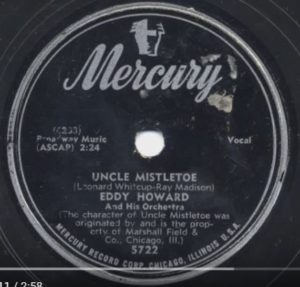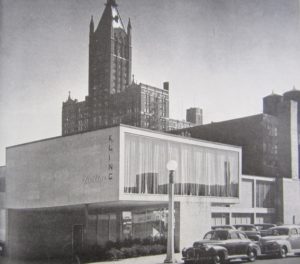
Like ants attacking a piece of chocolate cake during a summer’s picnic, the machines with giant iron claws have made fast work of Oprah Winfrey’s Harpo Studios on Chicago’s Near West Side; and with its demise goes a landmark of Chicago pop culture.
Most people still well remember the “Queen of daytime,” Oprah Winfrey, whose program reigned for over two decades as the most influential daytime talk show on national television, ever. It was here in her building that Tom Cruise seemingly acted irrationally by jumping on Oprah’s couch during a nationally televised interview and the term “jumping the couch” entered the American lexicon. Movie stars, celebrities of the moment and Presidential wannabes all flocked to Chicago to be on the Oprah Show. Yet there is a deeper history to this building that far out-dates Oprah Winfrey and Harpo Studios. This building was one of the early incubators of the television entertainment production industry thanks to Kling Studios.
Chicago’s genesis as an early incubator of the television entertainment industry starts with another icon of Chicago culture: Rudolph the red-nosed reindeer. As most Chicagoans are aware, Rudolph and his luminous proboscis were the creation of a Chicago ad-man, working for the Montgomery Ward company, that became an international sensation. Rudolph was launched just prior to World War II but it was the release of the Gene Autry song in 1949 that put Rudolph at the height of worldwide popularity and made him into an enduring Christmas icon. Another, perhaps jaundiced, Chicago retailer, Marshall Field, took notice and wanted a similar marketing program for their trademarked Christmas window display characters: Uncle Mistletoe and Aunt Holly.
There would be original music composed and released by Chicago-based Mercury Records, graphic books like the Little Big Books, Christmas ornaments and a television program. Rudolph would not make it onto the small screen for another ten years. The problem was, Marshall Field’s ad-agency didn’t know how to produce a television program, no one did; television was in its infancy. Marshall Field had been an early advocate for television with live demonstrations in their State Street store and they had sponsored one of the first pioneering programs broadcast in Chicago, but those programs were live while Uncle Mistletoe would be animated which had never been done before. Field’s ad-agency took the job to Kling Studios which was an art shop with a reputation for excellence in photography and commercial graphic art.

Original music for Marshall Field’s ad campaign
Kling had been founded by two artists, Robert B. Eirinberg and Wendell Kling, in 1932 at the very depth of the Great Depression. Despite the inclement economic conditions, Kling prospered and garnered clients from across the country. By 1945 at the conclusion of the Second World War, Eirinberg had built a new studio on land leased from Northwestern University at 601 North Fairbanks Court in the thriving River North neighborhood. Chicago was still home to several large advertising agencies most of whom had their offices in this area. There were several nationally admired art shops in Chicago that served the advertising industry but they mostly specialized in just graphic art while Kling had both graphic art and photography at which they excelled. It was just logical for Marshall Field’s ad-agency to approach Robert Eirinberg first.

Kling’s River North studio in 1949 (Architectural Forum)
Kling Studios soon had twenty-six fifteen minute episodes of Uncle Mistletoe and Aunt Holly on film for television broadcast. Arguably, it was the first true television animation. There had been several earlier animations but they generally were rather primitive, consisting of a series of story boards with talking actors; while Uncle Mistletoe played like animations produced for the movie theaters. While the Uncle Mistletoe marketing campaign never brought the international celebrity that Rudolph the Red-Nosed Reindeer had garnered, it became popular in Chicago and the Midwest for years thereafter. Occasionally at Christmas a Chicago television station will still show a snippet but most of the segments, if they still exist, have not been rebroadcast.
Uncle Mistletoe had caused Robert Eirinberg to see the future. If Marshall Field wanted a television program or a commercial, no doubt others would as well. Eirinberg hired a local radio disk jockey, Fred A. Niles, to head a new division for the production of television programs and commercials. It was no small provincial operation. They opened offices around the country and bought a long term lease on a production studio in Southern California that had once belonged to Charlie Chaplin; it was where such classic films as City Lights had been produced. In Chicago, they bought a building at 1058 West Washington that had once served as a roller rink and an armory. It had a large clear span interior which was perfect for a soundstage. At mid-twentieth century the new Kling Studio in Chicago was the largest soundstage in America west of Los Angeles and with a reputation established with Uncle Mistletoe, companies came to Kling for a television commercial or to convert an existing entertainment property to a television program.
The Hormel company, the Minnesota meatpacker that gave America that culinary oddity called Spam, came to Kling to convert the Hormel Girls into a television program. Now mostly forgotten, the Hormel Girls was the only all-female big band in America and they had become quite popular. Jay Hormel, the company president, felt that women musicians who had served in the military during the war hadn’t been treated as favorably as the men so he put together his own company band with former service women and had them tour America. Hormel used some of the same tactics as Chicago’s minstrel managers in the late 1800’s. The band would enter a town in forty white cars prominently displaying the Hormel name then the band would give a musical concert while praising the culinary virtues of Hormel meat products. Or as one wag put it: it was a musical meal of “Spam and legs.” Still with a nationally broadcast Saturday night radio program, the Hormel Girls had celebrity and Jay Hormel wanted his girls to be seen as well as heard so he bought the band to Kling Studios in Chicago to be on television.
Kling was soon busy with the production of television programs and commercials. Besides the Hormel Girls, Kling produced a series of country music concerts called the Old American Barn Dance. While the producers of the long popular National Barn Dance radio program produced in Chicago failed to avail television, the Old American Barn Dance would be enjoyed for years on independent television stations across the heartland.
Behind the fuzzy black and while television programs that fascinated post-war America were two competing business models of production and distribution. The national network stations produced most of their entertainment live and made recordings of the program for their affiliates, who were not yet connected by A.T. & T. to the network, using a devise called a Kinescope or Kinephoto. Kling and several other television pioneers like Ziv in Cincinnati and Revenue Productions in LA filmed their programs then syndicated the product to independent stations across the country. Kling had built a substantial library of product including the Old American Barn Dance, Uncle Mistletoe, the Hormel Girls, Boxing at Rainbow, Fun Facts, and several less successful properties that they syndicated to anyone who would broadcast them. The producers of filmed programming thought the future would be theirs because it was simply a superior product. While filmed programs were always commonplace on television up to the digital era, the future didn’t belong to the independent filmed program producers. In 1955, the networks began to replace Kinescopes with new magnetic strip tape recorders.
The year 1955 had other deleterious developments for the independent producers as well. This was the year A.T. & T. had finally connected Los Angeles to the national cable network and CBS, the second largest network, had completed their new production facility called CBS Television City. NBC quickly scrambled and built their own studio in Burbank. Kling would now be competing against the two giant distributors in the studio production market and it was not an equal competition.
In 1955 Kling Studios seemed to be at its apogee of success but again Robert Eirinberg saw the future and decided it was time to retreat. He sold the lease to his California studio to a movie production company and sold the Kling television division to Fred A. Niles who incorporated his own production company. Eirinberg took Kling Studios back to their roots as a commercial art shop serving the advertising industry while Niles operated the West Side production plant for small jobs. While his soundstage was too small for the a typical television comedy or drama, it was still the largest facility in Chicago. For three decades, Fred Niles was able to survive as a niche player producing commercials, industrial films and educational films. No job seemed too small. They even produced slide shows for corporate clients. But it all ended in 1983 when Niles was struck by a disease and passed away.
The Kling Studios/ Fred A. Niles Communication soundstage was not dark for long. A young Oprah Winfrey purchased the building to produce her own syndicated talk show in 1986.
With a history of over six decades of some kind of television program production, there is certainly a case to be made that the Kling Studios\Niles Communication Center\ Harpo Studios is a historical landmark. It was one of the oldest television soundstages in America. And yet when the Chicago Department of Planning and Development’s Division of Historic Preservation conducted a survey of “all buildings, objects, structures and sites constructed in the city prior to 1940” for the Commission on Chicago Landmarks, they identified approximately 9,900 properties in Chicago “considered to have some historic or architectural importance,” but the Kling\Harpo Studios building wasn’t one of them.
It wasn’t just the professional staff in City Hall that assessed this place as insignificant so did the Historic Preservation institutions. Bonnie McDonald, the President of Landmarks Illinois, the organization that publishes an annual list of most endangered Illinois landmarks, when queried stated: “It has, unfortunately, been altered in such a way that it was passed over in the survey due to its lacking integrity.” A building, structure, object or site may be a landmark due to its architectural significance or its historical importance. In the case of 1058 West Washington, landmark designation would rely entirely on the later. It wasn’t that the building was visually displeasing; rather that it was something of a muddle and none of the architects who had worked on the building had any celebrity. If just one doorknob had been designed by Frank Lloyd Wright or Louis Sullivan, it might have been a different situation. The case for 1058 West Washington was based on a history of early television of which few in Chicago are even cognizant.
In Chicago, when the early years of television are recalled, it is the programs produced at NBC’s Chicago outlet, WMAQ, that is remembered, the Dave Garroway Program, Kukla, Fran and Ollie or Stud’s Place starring Studs Terkel. When NBC opened their new production studio in Burbank, California in 1955, they ended all network production in Chicago. Some older Chicagoans still rue their passing. It was called the “Chicago School of Television” and it did have a unique style that others came to emulate. Many of the programs produced at Kling especially the several country music and popular music programs were never broadcast in Chicago but they were seen by other parts of the country and for a longer period of time. Kling and Niles had an impact on Chicago’s culture but for Chicagoans, it was a stealth presence. Niles in the 1950’s claimed that seventy percent of all the filmed television commercials broadcast in Chicago had been produced in their Washington Street studios. For the first several decades of the television era, Chicagoans were viewing something originally produced in this building, but no one was cognizant of such.
For Chicago’s political leaders, it was probably a blessing that a movement of pitchfork wielding preservationists demanding landmark designation did not appear at City Hall or anywhere else. Commerce could then trump culture. Oprah herself had tried to save the studio after she retired her program by producing another talk show headed by Rosie O’Donnell but O’Donnell didn’t have the mettle to attract a big enough audience on a pay channel. There is actually a surplus of talk show appropriate soundstages in Chicago mainly due to the crony capitalism of Connecticut. The practice of offering tax incentives to lure movie and television producers is a century old Government tactic. The giant Universal City in California built in 1915 received tax credits; but Connecticut took the practice to a new level of largesse in 2009 and several programs left Chicago and New York for Stamford, Connecticut. That alone probably doomed Harpo Studios. Logically, the City’s leaders would not want to buy a building that could not generate revenue while the land under the building continued to accrue value. A new building on this site with Ronald McDonald and his happy meal friends will provide a huge economic boost to the City. Unfortunately, Chicago has lost a true historic landmark of popular culture and Chicago’s television production industry continues to decline.
For more about Chicago’s involvement in the television production industry, please read Chicago’s Radio & Television Industry History.

We are definitely influenced along with your ability as a copywriter and also together with the shape on your weblog. Is this fact a compensated motif as well as does one customize it yourself? In either case continue the wonderful high quality crafting, it is really extraordinary to take a look an incredible blog exactly like it nowadays.